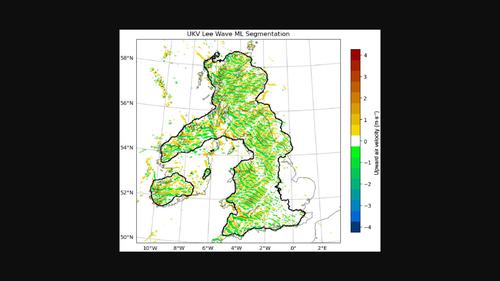Identifying and characterising trapped lee waves using deep learning techniques
IF 3
3区 地球科学
Q2 METEOROLOGY & ATMOSPHERIC SCIENCES
引用次数: 0
Abstract
Trapped lee waves, and resultant turbulent rotors downstream, present a hazard for aviation and land‐based transport. Though high‐resolution numerical weather prediction models can represent such phenomena, there is currently no simple and reliable automated method for detecting the extent and characteristics of these waves in model output. Spectral transform methods have traditionally been used to detect and characterise regions of wave activity in model and observational data; however, these methods can be slow and have their limitations. Machine‐learning (ML) techniques offer a new and potentially fruitful method of tackling this problem. We demonstrate that a deep‐learning model can be trained to accurately recognise and label coherent regions of lee waves from vertical velocity data on a single level from a high‐resolution numerical weather prediction (NWP) model. Using transfer learning, wave characteristics (wavelength, orientation, and amplitude) can be extracted from the trained segmentation model. The use of synthetic wave fields with prescribed wave characteristics makes this transfer learning possible without the need to characterise real complex wave fields. Addition of noise to the synthetic data makes the models more robust when applied to more complex and noisy NWP data. The collection of trained models produced provides a valuable tool to investigate the prevalence and nature of lee wave activity, as well as a new way for forecasters to detect resolved waves. The deep‐learning model was more capable and quicker at detecting and characterising lee waves than a spectral technique was. This work is just one example of how already established ML techniques can be used to detect and characterise complex weather phenomena from NWP model output and observational data, and how the careful use of synthetic data can reduce the requirements for large volumes of hand‐labelled training data for ML models.

使用深度学习技术识别和表征捕获的背风波
被困的背风波,以及由此产生的湍流旋翼,对航空和陆基运输构成了威胁。虽然高分辨率数值天气预报模式可以表示这种现象,但目前还没有简单可靠的自动化方法来检测模式输出中这些波的范围和特征。光谱变换方法传统上被用来探测和表征模式和观测数据中的波活动区域;然而,这些方法可能很慢,并且有其局限性。机器学习(ML)技术为解决这一问题提供了一种新的、可能富有成效的方法。我们证明了可以训练深度学习模型来准确识别和标记来自高分辨率数值天气预报(NWP)模型的单一水平上的垂直速度数据中的背风波相干区域。使用迁移学习,可以从训练好的分割模型中提取波的特征(波长、方向和振幅)。使用具有规定波特性的合成波场使得这种迁移学习成为可能,而不需要表征真正复杂的波场。在合成数据中加入噪声使模型在应用于更复杂和有噪声的NWP数据时具有更强的鲁棒性。所产生的训练模型集为研究背风波活动的普遍性和性质提供了一个有价值的工具,也为预报员探测分辨波提供了一种新的方法。与光谱技术相比,深度学习模型在检测和表征背风波方面能力更强,速度更快。这项工作只是已经建立的机器学习技术如何用于从NWP模型输出和观测数据中检测和表征复杂天气现象的一个例子,以及如何仔细使用合成数据可以减少对大量手工标记的机器学习模型训练数据的需求。
本文章由计算机程序翻译,如有差异,请以英文原文为准。
求助全文
约1分钟内获得全文
求助全文
来源期刊
CiteScore
16.80
自引率
4.50%
发文量
163
审稿时长
3-8 weeks
期刊介绍:
The Quarterly Journal of the Royal Meteorological Society is a journal published by the Royal Meteorological Society. It aims to communicate and document new research in the atmospheric sciences and related fields. The journal is considered one of the leading publications in meteorology worldwide. It accepts articles, comprehensive review articles, and comments on published papers. It is published eight times a year, with additional special issues.
The Quarterly Journal has a wide readership of scientists in the atmospheric and related fields. It is indexed and abstracted in various databases, including Advanced Polymers Abstracts, Agricultural Engineering Abstracts, CAB Abstracts, CABDirect, COMPENDEX, CSA Civil Engineering Abstracts, Earthquake Engineering Abstracts, Engineered Materials Abstracts, Science Citation Index, SCOPUS, Web of Science, and more.

 求助内容:
求助内容: 应助结果提醒方式:
应助结果提醒方式:


